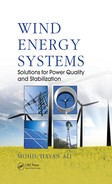Contents
1.4 Advantages and Disadvantages of Wind-Generated Electricity
1.4.1 A Renewable Nonpolluting Resource
1.4.4 Supply and Transport Issues
1.5 Worldwide Status of Wind Energy
1.5.11.2 Mexican Power Generation System
1.5.12.1 130 MW Installed in Africa and Middle East
Chapter 2 Wind Energy Conversion System
2.4 Basic Components of a Wind Turbine System
2.5.1 Wind Turbines Based on Axes
2.5.1.1 Vertical Axis Wind Turbines
2.5.1.2 Horizontal Axis Wind Turbines
2.5.2 Wind Turbine Power Scales
2.5.3 Wind Turbine Installation Location
2.6.1 Power Output from an Ideal Turbine
2.6.2 Power Output from Practical Turbines
2.6.2.1 Wind Turbine Design Speed
2.6.2.3 Effect of Wind Shear and Tower Shadow
Chapter 3 Electric Machines and Power Systems
3.3.1.1 Principle of Cylindrical-Rotor Synchronous Generators
3.3.1.2 Automatic Voltage Regulator System
3.3.1.3 Governor Control System
3.3.1.4 Power System Stabilizer
3.3.1.5 Operating Principle of Synchronous Motors
3.3.1.6 Permanent Magnet Synchronous Generator
3.3.1.7 Multimass Shaft System of Synchronous Generator
3.3.2.3 Induction Generator or Asynchronous Generator
3.3.3 Synchronous Reluctance Machine
3.4.1 Conventional Power Generation
3.4.2 Electric Power Transmission
3.4.2.1 Line Parameters for Overhead Transmission Line
3.4.3 Electric Power Distribution
3.4.6 Per-Unit System and Base Quantities
3.4.6.2 Per-Unit and Percent Admittance
3.4.7.6 Detecting and Locating Faults
3.4.8.1 Classification of Stability
3.4.9.4 Types of Circuit Breakers
3.4.10.1 Active Power-Frequency Control
3.4.10.2 Reactive Power-Voltage Control
3.4.10.3 Methods of Voltage Control
4.7 Pulse Width Modulation Scheme
5.2 Fixed-Speed Wind Energy Conversion Systems
5.3 Variable-Speed Wind Energy Conversion Systems
5.5 Wind Generator Characteristics
5.6 Maximum Power Point Tracking System
5.7 WG Total Efficiency Calculation
5.7.1 Outline of the Calculation Method
5.7.2.3 Copper Losses and Iron Loss
5.7.2.4 Bearing Loss, Windage Loss, and Stray Load Loss
5.7.5 Simulation Result with Transient Phenomenon Considered
5.7.6 Efficiency Calculation Using a Probability Density Function
Chapter 6 Wind Generator Grid Integration Issues
6.2 Transient Stability and Power Quality Problems
6.4 Power, Frequency, and Voltage Fluctuations Due to Random Wind Speed Variation
6.5 Grid Connection Requirements
6.5.1 Islanding and Auto Reclosure
6.6 Design and Operation of Power Systems
6.9 Wind Power’s Contribution to System Adequacy
Chapter 7 Solutions for Power Quality Issues of Wind Generator Systems
7.2 Various Energy Storage Systems
7.2.1 Superconducting Magnetic Energy Storage
7.2.2 Battery Energy Storage Systems
7.2.4 Flywheel Energy Storage (FES)
7.2.5 Pumped Hydroelectric Energy Storage
7.2.7 Compressed Air Energy Storage
7.2.8 Thermoelectric Energy Storage
7.2.9 Hybrid Energy Storage Systems
7.3 Energy Storage Systems Compared
7.4 Using SMES to Minimize Fluctuations in Power, Frequency, and Voltage of Wind Generator Systems
7.4.1 Method of Calculating Power System Frequency
7.4.2 Simulation Results and Discussions
7.4.3 SMES Power and Energy Ratings
7.5 Power Quality Improvement Using a Flywheel Energy Storage System
7.5.3 Microgrid System Operation
7.5.4 Control of Flywheel Energy Storage System
7.6 Constant Power Control of DFIG Wind Turbines with Supercapacitor Energy Storage
7.6.1 Control of Individual DFIG Wind Turbines
7.6.4 Configuration and Control of the ESS
7.6.5 Wind Turbine Blade Pitch Control
7.6.6 Wind Farm Supervisory Control
7.7 Output Power Leveling of Wind Generator Systems by Pitch Angle Control
Chapter 8 Solutions for Transient Stability Issues of Fixed-Speed Wind Generator Systems
8.4 Superconducting Magnetic Energy Storage Method
8.4.1 PWM Voltage Source Converter
8.4.2 Two-Quadrant DC-to-DC Chopper
8.5 Static Synchronous Compensator (STATCOM) Method
8.7 Superconducting Fault Current Limiter Method
8.8 Stabilization Methods Compared
8.8.2 Control Structure Analysis
Chapter 9 Fault Ride-Through Capability of Variable-Speed Wind Generator Systems
9.2 Doubly Fed Induction Generator Systems
9.3 Wound Field Synchronous Generator Systems
9.3.4 Grid Side Inverter Controller
9.4 Permanent Magnet Synchronous Generator Systems
9.4.1 Control of Back-to-Back Converters
9.4.4 Design Example for the ESS
